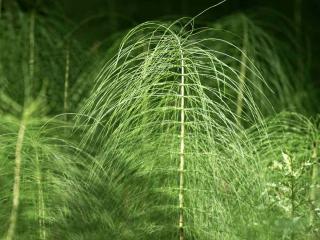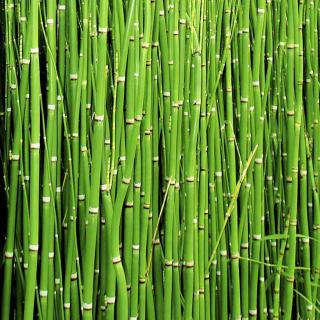

Fermented horsetail tea is an effective fungicide that helps avoid most fruit tree and vegetable patch diseases.
Horsetail can be harvested virtually anywhere since it is one of the most common wild plants. Fermented tea is very easy to prepare from it, and waiting time before use is short.
Finally, avoid growing it in your own garden, it is a truly invasive species that will overtake your plot unless you lock it in as if it were bamboo!
An alternative is to have it grow in a large tub. It also does great at the foot of conifer hedges, that can be locked in by pavement on either side.
Read also:
This technique is a simple two-week cold maceration: no boiling, just waiting.
 Harvest 35 oz (1 kg) fresh leaves.
Harvest 35 oz (1 kg) fresh leaves.An alternative recipe, instead of two-week cold maceration, is to let it macerate for only 24 hours. After this day-long maceration, boil the leaves and water together for 20 minutes. Cool and filter before use. This makes the fermented tea available for use much earlier.
Boiling, however, degrades some of the nutrients of the plant so it won’t have such a high fertilizing side-effect, but that’s a secondary consideration when treating against diseases.
Out of season, it’s hard to get fresh horsetail. You can still make this “magic potion” from dried horsetail! That way, all you need to do is dehydrate the weeds in season and then rehydrate them later on, when you need to use the plant.
Powdering helps the plant break down faster when preparing the mix, but it will also work well with whole dried plants.
Again, you’ve got two options here: you’ll get more nutrients if you ferment this material, but you can use your mix faster if you boil it. For both options, just follow the steps described above, adjusting for dried weight (use only 10% of the basic recipe).
Other than that, follow the same process!
Fermented horsetail tea is mainly used in spring and in fall, when diseases are most certain to appear.
Mixing ratio is 10% fermented horsetail tea to 90% water.
Spray regularly to avoid all chance of disease.
Horsetail tea is particularly effective against:

Again, choose a sealed container that is not made from metal.
Use a wood barrel or plastic jug or barrels.
Avoid iron, copper and other metal-like containers since they would react with active ingredients and render them ineffective.
Most important is to keep the fermented tea “alive”: all yeasts contained in such fermented weeds must be protected from freezing and from heat waves.
Although the base material is free, the time you put in it needn’t go to waste. You can spray leftover tea on healthy plants to give their immune system a boost, too!
Indeed, sometimes fungal diseases are present even if the plants don’t show any symptoms yet. For instance, on some Septoria host plants like tomato, incubation can last from 2 to 4 weeks before the first spots appear.
When planting flowers or preparing soil mix, moisten the soil up with fermented horsetail tea to cleanse it from damaging fungus.
Read also:
I have a solar dehydrator. If I dry some horse tail, then power it in my food blender until a powder, could I activate it when I want to use it by taking some powder, boiling it up in a saucepan, wait to cool down, adding some yeast and let it ferment and then use it diluted? If you think it is a good idea then what ratios would you suggest I use? Does going through the fermenting process make any difference? If so, do you know why?. With thanks
With thanks
Hi Alexander, what you’re describing would also work. In terms of absolute effectiveness, it’ll always be a bit less effective than the basic “ferment from fresh horsetail without boiling” technique, but it’ll still give you good results. Note that you don’t need to boil the material, unless you’re in a hurry to use it. The fermenting will start off better if you don’t boil it, actually.
Adding yeast – I’m supposing bread yeast or kombucha yeast or something like that, or simply throwing in any other weed that grows around without cleaning it – will help break down dried and re-hydrated horsetail material. The yeast not only makes compounds available, it also produces its own compounds that enrich the mix. As in most things natural, the more, the merrier!
So it’s the combination of horsetail compounds + yeast compounds that makes the mixture really potent. There’s a whole section on why fermenting is important for this spray here.
What does the measuring look like if we use horsetail powder – our red robin tree (3 m) caught the fungus – we use powder because of COVID-19 lockdown all gardening shops and supplies are closed. Love your biological solutions.
Hi Brigitte, thanks for liking what we do! Trying our best. From a nutrient and physical compound point of view, fresh horsetail is usually 90+ % water. So instead of 1 kg fresh leaves, you would use 100g. Instead of 35 oz, just 3.5 would do. One-tenth the fresh amount.
However, to speed the fermenting, it’s important to get “some” fresh material. Yeast that lives on the plant itself is what starts fermentation. Try to get your hands on any type of weeds you can. For instance, you could chuck in a couple handfuls of dandelion leaves, nettle, or any other plant. Better if it grows low on the ground (higher chance of yeast-filled leaves). Even grass will do.
If you don’t add fresh weeds, it will still ferment but it’ll take longer since the only source would be air-borne yeasts that would drop in by chance.
OMG thank You! For the quick reply. And the help. Will do. I very very thankful.
Thoroughly enjoyed reading through the various methods to control pests and fertilize next years plants too.
I will be gathering nettles in my local woods where they grow to access in the spring onward and following your brilliant advice.
Thanks.
Thanks a lot for your comment, it’s very kind of you. Using such methods are excellent for the planet, too, since they’re all in one organic, local, and biodegradable. Glad you like it!
I will have to try it on our apple trees
Sure thing, Michael! I’m sure your apple trees will love the help from these plants, and it’ll probably feel great to get rid of those weeds in a useful manner!